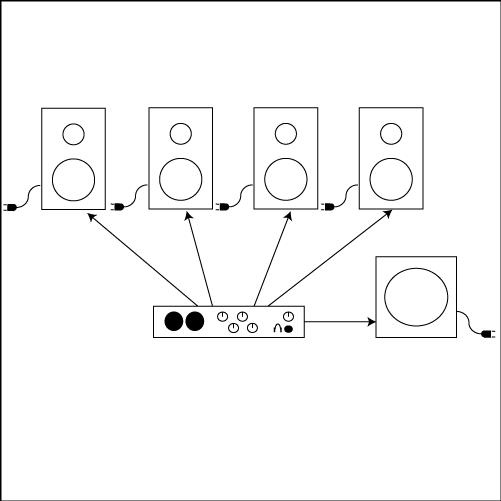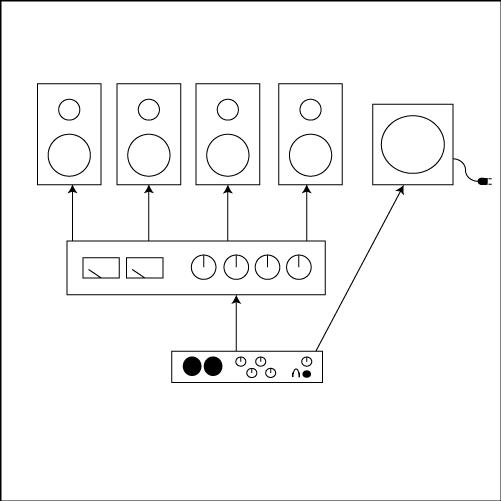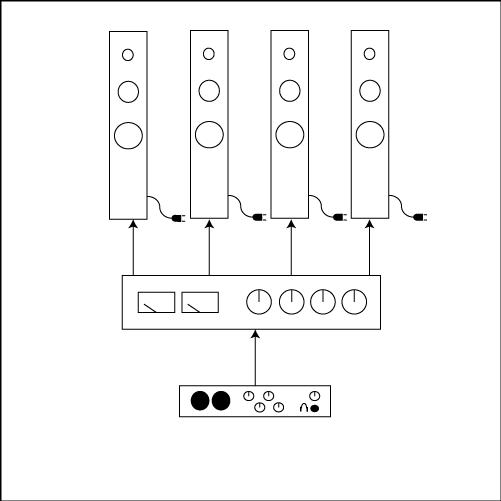

Considerations When Choosing Speakers For Hauptwerk
2015-08-20 - Hauptwerk TechnicalSpeakers are often the weak link in many people's audio systems. They are the final component that the audio signal passes through before it's released into the wild. Choosing the right speaker has a profound influence in shaping the sound and directing the sound.
Talking about speakers for Hauptwerk is a huge topic. Choosing the right speaker depends on so many factors that it's highly contextual and highly subjective.
I'm going to take a middle path and outline some of the basic speaker types, list their normal uses, highlight their advantages and limitations. Hopefully, that will help you to select speakers that will work for your situation.
Cheap Speakers vs. Great headphones
For those of you who have budget issues nagging uncomfortably at your conscience you can still get great sound from your Hauptwerk system. As a rule, if you have only a little money to spend on speakers, you're best to spend that money and get a fantastic set of headphones instead of a cheap set of speakers. Your money will be much better spent on the headphones.
Some headphones are so good that they fool you into thinking you're hearing things in the room. See my article "Where "Good" and "Cheap" Belong in the Same Description - A Headphone Love Story" for recommendations and anecdotes.
If funds free up later for some great speakers, great! You'll still have a killer set of headphones that you'll never be sorry you bought. Your significant other will likely also not be sorry that you can still practice quietly.
When Being Bipolar is a Good Thing
Even under ideal conditions, there will still be compromises when it comes to reproducing the sound and effect of a pipe organ with speakers. One of the big issues is that real pipes resonate and throw off sound in 360 degrees. Arguably, some of that is obstructed by other pipes. However, most traditional speakers max out at 90 degrees (120 degrees if you're lucky).
Professional audio products are designed to be even more focused in their sound dispersion because you absolutely do not want sound going all directions in a studio environment or in, say, an arena. Those products are hyper-focused. They're like the snipers of the audio world. You literally have to aim them at your head.
Bipolar speakers are the other end of the dispersion spectrum. They have speakers on both the front and back of the speaker. So, they have a wide dispersion pattern that relies on the sound bouncing around the room in order to give a very life-like feel to the sound. In blind listening tests, people enjoyed listening to music from bipolar speaker more than listening to direct sound speakers (where all the speakers are at the front of the speaker box).
Here's a great article from a while ago explaining why in more detail. It's called "Is Bipolar Dead?"
If you get these speakers, you'll need to have enough room to have them stand 1' to 2' out from the wall. This will allow them to do their work well. Bipolar speakers have a good pedigree for use with virtual pipe organs. They were used extensively with the first, premier virtual pipe organ of all; the Marshall & Ogletree organ from Trinity Wall Street.
These will typically start in the $800+ each range. Sometimes you can find them used or in close-out sales for less.
Being Monitored (or "Aimed Right At Your Head")
By far the most popular solution for Hauptwerk users is to buy pro-audio or prosumer monitor speakers. These speakers are primarily designed for use in commercial and home recording studios.
What is great about them is that most of them have built-in amplifiers and that they're very compact. They also are very simple to use with the kinds of jacks and cables that make them a no-brainer.

There is also a very wide selection of quality and price ranges to choose from. You can get a pair for as little as $300 or as much as several thousand dollars a pair. While the ones that are thousands of dollars per pair are, indeed, better than the cheap ones by leaps and bounds, their value to an organ project becomes less so when you realize that you really need multiple pairs of these speakers to do things right.
If you're going to have a lot of them, you do need to think about power. Each speaker has it's own powered amplifierr. This means you need a 110V or 220V power plug for each speaker. So keep that in mind.
See the article "Hauptwerk Through The Church's House System" for a deeper explanation of why you need more than 2 channels of output for your Hauptwerk instrument.
There are a couple of things you need to consider when looking at using monitor speakers for your Hauptwerk system.
Monitor speakers tend to have a relatively small frequency range when compared to regular full range stereo or home theatre speakers. It's not uncommon for a good studio monitor might have a range of 37Hz to 30 kHz where a good full range home theatre speaker would have 20 Hz to 30 kHz. The problem with that is that you need a minimum of 32 Hz in order to reproduce the sound of a 16' pipe.
The reason the studio monitors do not go down very low is because they are usually designed to be sold with an accompanying sub woofer.
"Ah" you say. "Problem solved. I'll just get the sub".
However, recording and mixing pop music doesn't usually use the same range of frequencies that a pipe organ will use. So, it's also common that the accompanying sub is only designed to go down to 29.5 Hz. So, now you have your 16' pipes but not a lot below that. You'll need to find another sub solution that, ideally, can handle down to 16 Hz and move a lot of air.
The other concern about monitor speakers is that they are designed to be aimed directly at your head. Your head is supposed to become the "sweet spot" where the best sound converges. This is great if you're the only one listening to the output of the organ. It's not so optimal if others need to listen as well.
This focused sound also makes the origin of the sound very identifiable which is very unlike how a pipe organ works. You will be able to point to exactly where the sound is coming from. Purchasing multiple pairs of monitors can help to lessen this effect to some degree.
Bookshelf Speakers
Sometimes, you can get the same form-factor of monitor speakers in un-powered bookshelf speakers. These typically have better dispersion than monitor speakers. The only drawback, compared to the monitor speakers, is that they need to be powered by an amplifier.

Stand Alone Sub Woofers
The main thing to look for with subwoofers is the lowest frequency it can handle. As mentioned before, you need a sub that can reproduce 16 Hz if you want it to reproduce a 32' pipe. Even though you can't hear that low, you want to feel it.
In order to "feel" sound, the sub also has to be able to move some air. This will typically mean either having a physically large speaker or some sort of passive radiator as part of your sub.
You can ask other Hauptwerkers for recommendations on the make and model they use. This is important because some subs will handle the frequency but only for short periods of time. There was one popular sub that would blow a capacitor if too many 32' C notes were played for a long period of time. Sure it could handle the frequency but it was really designed for reproducing explosions in home theatres. It wasn't meant for sustained organ pipe frequencies at 16 Hz. (note that that model has been discontinued)
Speaking of special effects, many sub woofers have an LFE input. It's a single, RCA type input. This is not useful for Hauptwerk. LFE stands for Low Frequency Effects. As described above, it's meant for infrequent, short bursts of low frequencies. This is not useful for Hauptwerk.
Some features on your subs which are useful for Hauptwerk would be the ability to set the crossover frequency, stereo inputs, and phase adjustment.
Built-In Subs
My personal favourite speakers for Hauptwerk installations (especially church installation) are full range speakers with built-in, powered subwoofers. This means that the middle and high frequencies will need an external, amplified signal (connected to an amplifier). The subwoofer portion has it's own built-in amplifier. Some of these kinds of speakers are even bipolar.
Hauptwerk does not allow you to route audio signals by frequency. It allows you to route by rank or to use specific note cutoffs but that's not the same thing. For instance, even if you routed C-A of all of your 32' stops to a sub, you'd lose all of the treble from those pipes. You can add more speakers to handle the treble but then you have more complexity to the system and are wasting those speakers most of the time. It would be much better if you had full range speakers from the outset.

This is why I love full range speakers with built-in subs. I can send a full audio signal to the speaker and it will send the right frequency to the appropriate driver, using it's own crossovers. All I need to do is put as many of these speakers in an audio output group as possible and I maximize my number of sound sources for the purpose of multi-channeling. See the tutorial on "Multi-Channel Audio for Hauptwerk" or "Hauptwerk Through The Church's House System" to learn more about using as many speakers as possible at any given time.
The audio routing for this kind of system is dead simple and very efficient.
Again, if you're going to have a lot of them, you do need to think about power. Each speaker has it's own powered subwoofer. This means you need a 110 or 220V power plug for each speaker. So keep that in mind.
Another great thing about these kinds of speakers is that, since the sub-portion of the speaker is powered, all of the power from the amplifier goes to the mid and high frequencies. This means that you can use amplifiers with less power. None of that power is being sucked away by power-intensive lower frequencies.
Make sure that the built-in sub has the appropriate range you need for your organ setup. 32' pipes require that your sub be able to produce frequencies at 16 Hz. 16' pipes require that your sub can handle 32 Hz.
Mix & Match
One principle that you should absolutely adhere to is the need to standardize the speakers in any particular Hauptwerk audio group. This means that the all the speakers that share the burden of reproducing the same ranks of pipes should all be identical. Here is an absurd example to illustrate the point:
So, you have a bunch of odd speakers lying around. You have a pair of Radio Shack home stereo speakers from 1970. You have a cheap set of powered monitor speakers, and you have a pair of satellite speakers left over from your home theatre speaker set. You now have 6 speakers to play back your virtual organ.
You pull the Bourdon 16' and start to play a Chromatic scale starting on C. C plays through the Radio Shacks (both of them because you loaded the samples in stereo). The sound is pretty robust but there's not much in the way of the high frequencies. It's just a solid "whoomf" since those speakers were not known for their tweeters. You Play C#. Now the sound is coming from the monitors. Great clarity and character to the mids and highs but it's pretty underwhelming in the body of the sound because the monitors only go down to 37 Hz and roll off significantly thereafter. You play the D. Did somebody just play a whistle? Where are the lows and mids? Now you are fully acquainted with the harmonic content of a bourdon pipe sounding at 37 Hz but not much else.
On (hopefully) a less extreme level, this is what happens when you mix speakers within an audio group. Each speaker has a slightly different sound to it. Those differences will make the chromatic scale sound uneven. It's very much worth avoiding this scenario. So make sure all of the speakers in an audio group are the same. The one caveat to this principle is if you're using a sub to round out the low end of the group. You can include a sub in the group. Here is how to do it "Multi-Channel Audio for Hauptwerk".
If you absolutely must have different sets of speakers, you'll need to put them in separate speaker groups and route the ranks accordingly.
So...Where Do I Go From Here?
Before you go off and spend a bunch of money, you need to decide what do you need the sound system to accomplish.
Do you just need simple audio for the purposes of practicing? Then a couple of speaker and a sub would probably work. You could even get away with using a just a great set of headphones.
Do you want a system that is meant to provide an immersive, life-like experience that approximates the effect of a great pipe organ? If so, then you're going to need to look at getting as many channels as is possible and practical for your room. In a regular house, that typically means 6-8 channels plus a sub or two.
How many channels are you hoping to run? This is going to depend on your budget. If I have a set budget, I try and spend that money on a smaller amount of good stuff than a load of mediocre stuff. You can always add more later if funds come available. The items will sound better and last longer than the mediocre stuff.
If you order mediocre stuff now and decide to add good stuff later, you'll soon want to replace the mediocre stuff because you won't be able to ignore the difference in sound. The money you spent on the mediocre stuff will be wasted money then. However, if you buy good stuff now and add some more good stuff later, you haven't lost anything. You'll just have good stuff.
How much room do you have? How much room you have to work with will be a major factor in your decision making. It's not unlike figuring out how much pipe organ will reasonably fit in a particular worship space. Too little audio, it's underwhelming. Too much, and it's overkill. At least with virtual organs, you can turn the whole system down if you have to.
There's not much sense, for example, in getting 8 bipolar tower speakers for your Hauptwerk instrument and cramming them all into an 8' x 8' music room. This might be a good time to use some bookshelf speakers.
If you have the small room but like the big speakers, you can use fewer speakers. Later, if you move to a larger room, you can add more of the same speakers.
Yes But Who Do I Trust?
I'm sure that you have been reading this whole time waiting to hear mention of brands or model names in hopes that that will be the easy answer to your questions. I have tried to stay away from these because the model names tend to change with the season.
In general, we have had good success with Definitive Technology and Golden Ear speakers. You still have to pay attention to the specs on each model to make sure they will handle what you want them to. However, these have been great go-to manufacturers. They're not the cheapest but they give great performance for the money you do spend.
You can also call us 905-475-1263 or email us if you have specific questions about your own situation. We're happy to help.
I hope this helps,
Darryl
Comments
With ~200 cubic meters of living room air to be shaken at 16 Hz, I think that starting to save the money for the newly released GoldenEar SuperSub XXL would be reasonable.
Also, I guess I should rethink and revise my current multi-channel setup, where two of the audio groups each contain a combination of one full-range front speaker and one medium-range rear speaker.
Thanks a lot for that reminder, Darryl.
The readers might also be interested in, for audio interface outputs & powered studio monitor inputs, the difference between balanced and unbalanced cables.
Also, am I correct both the Definitive Technology and Golden Ear speakers that have powered sub-woofers also need an external amplifier for the mid-range and tweeters?
Thanks,
Jim